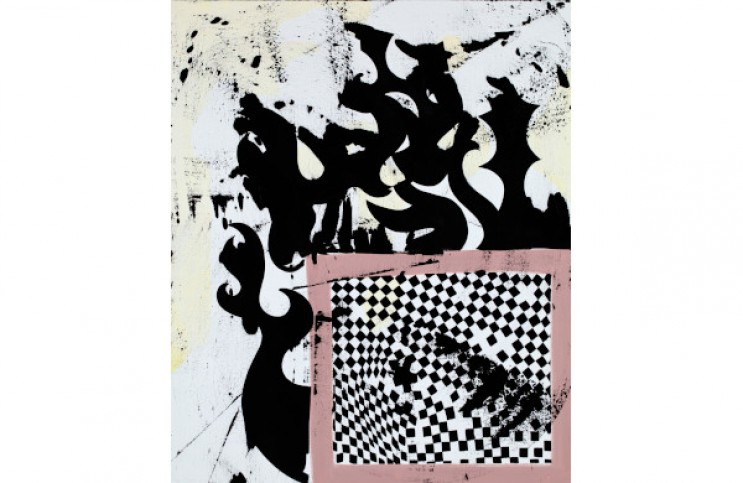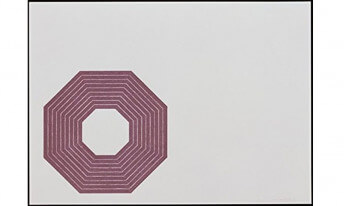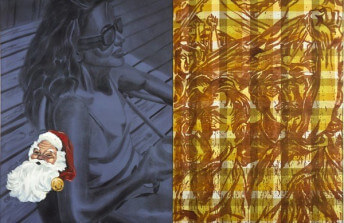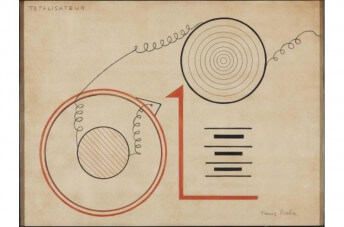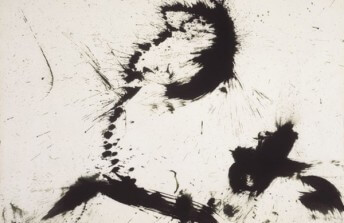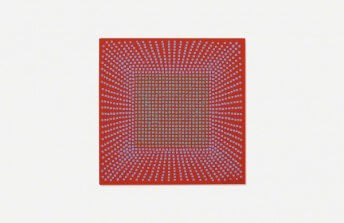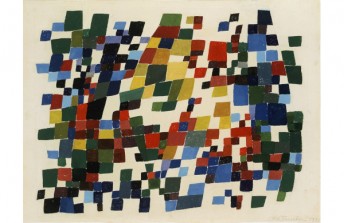Hirshhorn Extends Charline von Heyl’s Critically Acclaimed Exhibition
Apr 3, 2019
Two months after it opened at the Hirshhorn Museum and Sculpture Garden in Washington, DC, Snake Eyes, a retrospective of the work of Charline von Heyl, was closed to the public—a casualty of a prolonged shutdown of the American government due to budget disagreements between the President and the Congress. (The Hirshhorn is part of the Smithsonian Museum complex, the entirety of which was closed during the crisis.) Happily, however, the museum has extended the run of Snake Eyes. If you have not yet had the chance to catch it, you still have a few weeks left—it closes on 21 April. It is well worth the effort to make the trip. Not only is this likely to be the only appearance of the exhibition in the United States, von Heyl makes work that is truly, undeniably unique. She is one of a handful of painters working today whose paintings can be described as simultaneously Modern and Post Modern. The Post Modern influence is evident in her compositional strategies and choices of content, which combine innumerable historical references with a broad range of source materials and techniques. What is Modern about the work is the extraordinary ability von Heyl has to make her paintings seem new. The oppressive cynicism that usually accompanies Post Modernism assumes that everything has been done before, so there is little point of trying to be inventive. Von Heyl brazenly denies such pessimistic thinking, constructing fantastically complex works that confidently declare their novelty. According to von Heyl, her intention with each new painting she creates is to make “a new image that stands for itself as fact.” She is not beholden to any particular style or method, and most of her images bear little resemblance to each other. Yet there is something visceral about her works that convey the hand of their maker. Perhaps it is their wit, or their compositional structure, or the qualities of their surface. Or perhaps it is something less obvious, and more metaphysical that von Heyl manages to conjure something in her paintings, that announces they are undeniably her own.
From Inspiration to Intellect
In a recent interview with Jason Farago for Even magazine, von Heyl described the what inspires her to work every day in the studio. She said “I think it comes from being a fetishist. That started when I was a child. Every day, when I saw something gleaming in the street, I picked it up, and I immediately attached some meaning to it, one way or the other.” Her studio is home to a multitude of objects that caught her fancy for one reason or another, either because of their handmade qualities, or because of the history she senses within them. Although her paintings are not exactly inspired by these objects directly. It is more like the ideas that guide the work flow from their material presence or the stories they seem to tell. Her method may be random, and built on unexpected connections and leaps of the imagination. But looking at the paintings she has been making for the past 30 years, it makes perfect sense. They each contain the story of their own making—an aesthetic exploration of an intellectual thread, self-contained, self-referential, and rife with subjectivity.
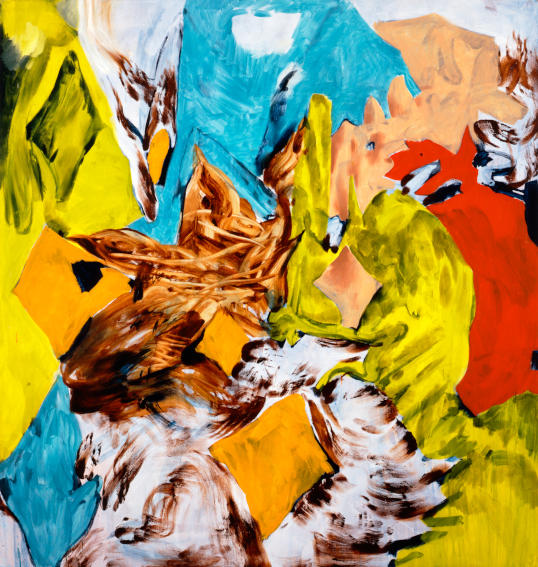
Charline von Heyl - Bluntschli, 2005. Acrylic and oil on canvas. 82 x 78 in. ©Charline von Heyl. Courtesy of the artist and Petzel, New York. Collection Ira G. Wool and Barbara Mirecki.
Yet as idiosyncratic as her paintings are, they share a definitive energy; like the power of attraction. Von Heyl spends months with each composition, intellectualizing the work, finding ways to lure the eye into the picture. She deploys formal elements like color, line, and graphic shapes because of the emotional impact she knows they will have on the viewer. Those elements are only tricks, however. They are not the point of the work—they are tools the artist uses to draw us nearer so we can become engaged with our own process of contemplation. If she is successful, we will have an emotional response to the work, although what emotion von Heyl hopes to inspire in us has changed over the years. “When I started out,” she told Farago, laughing, “I wanted the paintings to basically torture people. What I want now is something that seduces more than it angers.”
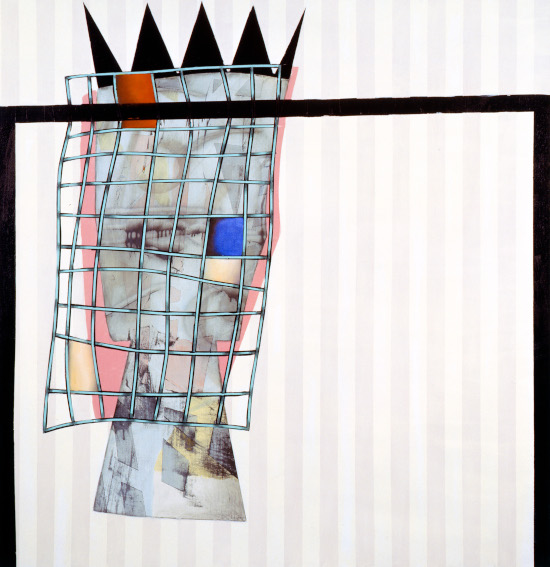
Charline von Heyl - Idolores, 2011. Acrylic and oil on linen. 62 x 60 in. ©Charline von Heyl. Courtesy of the artist and Petzel, New York. High Museum of Art, Atlanta, Gift of the Alex Katz Foundation, 2011.
Stay a While and Look
Snake Eyes is comprised of more than 30 large-scale paintings, offering a look back at the entire trajectory of her 30-year career. Astute viewers will easily be able to spot dozens of art historical references in the paintings—von Heyl adapts her visual language from sources as diverse as Pop Art, Op Art, Minimalism, Suprematism, Color Field Painting, Dada, Abstract Expressionism, and the Pattern and Decoration Movement, just to name a few. Mixed in with all of these abstract tendencies are healthy doses of figuration. In the painting “Yellow Guitar” (2019), the eye is unavoidably drawn to the image of a knife at the top and a wine bottle in the upper right corner. These recognizable pictures along with the vivid yellow checkerboard might send the mind on a foolish errand to try and find the guitar. The effort would be fruitless, because the meaning is not contained within what is recognizable.
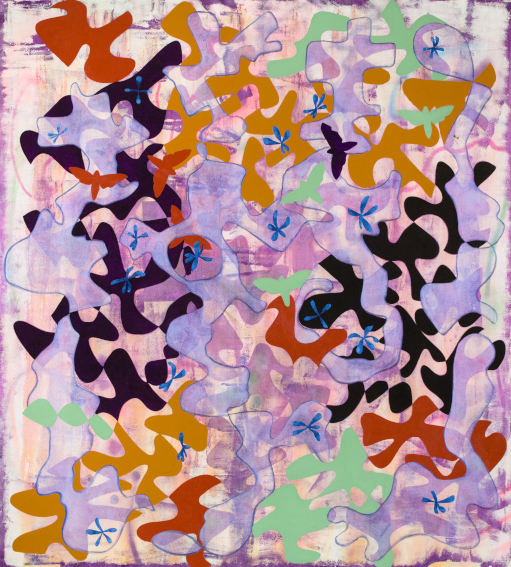
Charline von Heyl - Nunez, 2017. Acrylic, oil and charcoal on linen. 82 x 78 in. ©Charline von Heyl. Courtesy of the artist and Petzel, New York. Courtesy of the Artist, Galerie Gisela Capitain, Cologne and Petzel, New York.
Instead, for von Heyl, meaning awaits us in what we do not yet see. She refers to this part of her method as the quest to “make a painting more alive.” That mysterious quality—liveliness—abounds in the endless depths of the painting “Mana Hatta” (2017). As stenciled, polka dot rabbits dance across the surface, a ghostly, totemic, head-form shudders with spiraling circles and lyrical waves. Countless levels emerge and retreat, as the colors seem to evolve before our eyes. As with the interference paints she used to create this painting, which subvert the expected color values of the other mediums they come into contact with, von Heyl is always striving towards unexpected results. Her point is simply to convince us to stay a while and look, hoping that something invisible will emerge. Charline von Heyl: Snake Eyes is on view at the Hirshhorn Museum in Washington, DC, through 21 April 2019.
Featured image: Charline von Heyl - Catch Mad Wreck, 2011. Acrylic on linen. 60 x 50 in. Private Collection, New York. ©Charline von Heyl. Courtesy of the artist and Petzel, New York.
All images used for illustrative purposes only
By Phillip Barcio
